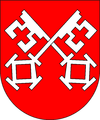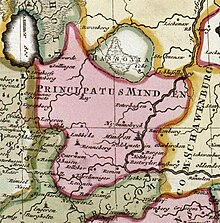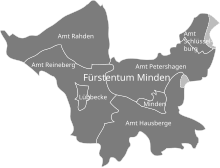Principality of Minden
|
Territory in the Holy Roman Empire |
|
|---|---|
| Principality of Minden | |
| coat of arms | |

|
|
| map | |

|
|
| Principality of Minden early 18th century, contemporary map
|
|
| Arose from | until 1648: Hochstift Minden |
| Today's region / s | DE-NW |
| Parliament | Reichsfürstenrat : 1 virile vote on the secular bench |
| Reichskreis | Lower Rhine-Westphalian |
| Capitals / residences | Minden |
| Dynasties | Brandenburg-Prussia |
| Denomination / Religions | Evangelical Lutheran |
| Language / n |
German
|
| Incorporated into | 1807: Kingdom of Westphalia
|
The Principality of Minden was a secular territory of the Holy Roman Empire . It was created in 1648 as a successor to the Minden bishopric , belonged to the Lower Rhine-Westphalian Empire and was in Brandenburg-Prussian ownership until the end of its existence in 1807 . From 1719 it was administered together with the neighboring county of Ravensberg in the Prussian administrative unit Minden-Ravensberg .
location
The principality was mostly north of the Wiehengebirge in the Mindener Land west of the Weser . Smaller areas were east of the Weser and in the Ravensberger Mulde south of the Wiehengebirge. In July 1806, the Principality of Minden bordered the Prussian County of Ravensberg and the Principality of Lippe in the south, the County of Schaumburg-Lippe and the Electorate of Hesse County of Schaumburg in the east, and the Electorate of Hanover and some of the Electorate of Hessen exclaves in the west and north .
The area of the former principality of Minden today belongs to the administrative district of Detmold ( Ostwestfalen-Lippe ) in the state of North Rhine-Westphalia and is divided between the districts of Minden-Lübbecke and Herford . In Minden-Lübbecke, most of today's municipalities were completely under the rule of the principality, of Preußisch Oldendorf only the districts of Hedem and Lashorst, of Bad Oeynhausen only the part north of the Werre . This means that the territory is largely congruent with today's Minden-Lübbecke district. In the district of Herford was the area of today's municipalities Löhne , today's Bünder districts Dünne and Spradow, today's Herford district Falkendiek, today's Vlothoer district Uffeln and the areas north of the Werre of today's municipality Kirchlengern .
history
The principality came into being in 1648 when, in accordance with the provisions of the Peace of Westphalia, the already largely Lutheran monastery of Minden was secularized and placed under the rule of the Electorate of Brandenburg to compensate for the loss of Western Pomerania that fell to Sweden. The government installed was initially in Petershagen , from 1650 temporarily and from 1669 permanently in Minden . From 1719 the Principality of Minden and the County of Ravensberg were administered from here by a war and domain chamber ( Minden-Ravensberg ). The administration of the offices was usually entrusted to tenants who were responsible for income from taxes, excise duties, customs duties and the like. a. had to worry.
In 1807 the territory of Napoleon I was added to the Kingdom of Westphalia , which marked the end of the territorial unit. When the Prussian state territory was reorganized in 1815 , the principality was not restored, but the title of Prince of Minden was retained in the Grand Title of Prussian Ruler. The area became part of the administrative district of Minden in the province of Westphalia and divided into the districts of Minden , Rahden , Bünde and Herford .
structure

The Principality of Minden last consisted of five administrative districts and two non-official Immediatstädten . The districts were based on the five state castles . Each of the offices except for the office in Schlüsselburg was divided into bailiwick districts or individual places. Each bailiwick district comprised several parishes with their farmers . In the end, the principality was divided as follows:
| Offices | Landesburg | Bailiwicks |
|---|---|---|
| free of charge | no | City of Minden , City of Lübbecke |
| Office local mountains | Schalksburg | Vogtei Überstieg, Vogtei Berg und Bruch, Vogtei Gohfeld , Vogtei Landwehr, (plus Flecken Hausberge) |
| Office Petershagen | Petershagen Castle | Vogtei Hofmeister, Vogtei Börde, Vogtei Windheim |
| Rahden Office | Rahden Castle | Vogtei Stemwederberg , Vogtei Rahden |
| Office Reineberg | Reineberg Castle | Vogtei Levern , Vogtei Gehlenbeck , Vogtei Alswede , Vogtei Quernheim , Vogtei Schnathorst , Vogtei Blasheim |
| Key Castle Office | Shlisselburg Castle | - |
From a tax point of view, from around 1734 - in the course of the formation of Minden-Ravensberg - the area was divided into two district supervisory districts, each comprising several offices, each of which was supervised by a district administrator at the top. These replaced the bailiwicks in terms of their importance, but not formally, and the Drosten became purely honorary posts. In the Principality of Minden, one district administrator (towards the end of the 18th century) was responsible for the offices of Hausberge, Reineberg (excluding the Bailiwick of Levern), Schlüsselburg and the Bailiwick of Windheim (from the Petershagen department), the other district administrator for the Rahden and Petershagen offices (excluding the Bailiwick of Windheim) and the Bailiwick of Levern. One of the most famous district administrators was Ludwig von Vincke , later President of the Province of Westphalia .
Princes
The princes of Minden after 1648 were the princes of Brandenburg and Prussian kings from the House of Hohenzollern as successors to the Minden prince-bishops :
- 1648–1688 Friedrich Wilhelm
- 1688-1713 Friedrich III .; from 1701 as Frederick I King in Prussia
- 1713–1740 Friedrich Wilhelm I.
- 1740–1786 Frederick II.
- 1786–1797 Friedrich Wilhelm II.
- 1797–1807 Friedrich Wilhelm III.
Even after the end of the principality, the kings of Prussia carried the title of Prince of Minden , most recently Kaiser Wilhelm II until 1918.
coat of arms
The coat of arms of the principality showed the crossed keys of St. Peter on a red background, turning their beards away . Peter was the patron saint of the diocese and Minden Cathedral . Before 1648 the coat of arms was the coat of arms of the bishopric of Minden and was included in the large Prussian coat of arms after 1648 . To this day it is represented in the coat of arms of many municipalities in the region, e.g. B. in the coat of arms of the city of Minden. The now dissolved districts of Minden and Lübbecke also had the keys in their coat of arms. The coat of arms of the Minden-Lübbecke successor district also takes up this old symbol.
literature
- Wolfgang Neugebauer : The stands in Magdeburg, Halberstadt and Minden in the 17th and 18th centuries. In: Peter Baumgart (Hrsg.): Estates and state formation in Brandenburg-Prussia. Results of an international conference. de Gruyter, Berlin / New York 1983 (publications of the Historical Commission in Berlin, vol. 55), ISBN 3-11-009517-3 , pp. 170–207; doi: 10.1515 / 9783110859515-012 .
- Hans Nordsiek : The Prussian Principality of Minden at the time of Frederick the Great , special edition, Kommunalarchiv, Minden 1986, ISBN 3-930222-33-7 , and in: Mitteilungen des Mindener Geschichtsverein , Volume 58 (1986), pp. 11-102.
- Hans Nordsiek: From the Principality to the Principality of Minden. Constitutional, political and denominational changes from 1550 to 1650 . In: Westphalian magazine . tape 140 , 1990, pp. 253-273 ( varl.de [PDF; 966 kB ]).
- Wilfried Reininghaus : Territorial archives of Minden, Ravensberg, Tecklenburg, Lingen and Herford , publications of the state archives of the state of North Rhine-Westphalia, series A, inventories of state archives, the state archive of Münster and its holdings, Vol. 5, Münster 2000. ISBN 3-932892- 12-7 ( online version ; PDF; 2.3 MB)
- Bernd-Wilhelm Linnemeier: Jewish life in the old empire. City and principality of Minden in the early modern period. Studies on regional history 15, Bielefeld 2002. ISBN 3-89534-360-9 .
Web links
- Document registers from the archives of the Principality and Cathedral Chapter of Minden / digital Westphalian document database (DWUD)
- Archives on the Principality of Minden and its territory in the State Archive of North Rhine-Westphalia, Department of Westphalia (until 2008, State Archive of Münster)
Individual evidence
- ^ Georg Galle: Chamber and Commissariat. The development of the chamber and commissariat administration in Minden-Ravensberg at the time of Friedrich Wilhelm I. Mitteilungen des Mindener Geschichtsverein, year 61 (1989), pp. 45–69.
- ↑ Bernd-Wilhelm Linnemeier: The sovereign domain economy and the offices of the principality of Minden. Investigations into their structure and appearance in the second half of the 17th century. Messages of the Mindener Geschichtsverein, year 64 (1992), pp. 49–80.
- ^ ArchiveNRW: Minden-Ravensberg, district administrators
Coordinates: 52 ° 21 ' N , 8 ° 47' E




